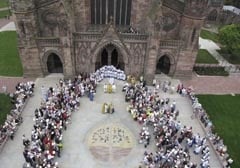Readers projects : Christ the Apple Tree
The tree of life my soul hath seen,
Laden with fruit and always green:
The trees of nature fruitless be
Compared with Christ the apple tree
A new pavement with a depiction of a symbolic apple tree outside the West Front of Hereford Cathedral was blessed by the Bishop on Sunday 2 October in front of the cathedral’s congregation.
The depiction of the apple tree, showing the different apples grown in Herefordshire, is an impressive tessellated pavement created from 3,000 individual pieces of English stone, shaped by hand at Forest of Dean Stone Firm’s factory at Parkend in Herefordshire and laid by local firm CJ Bayless using Steintec’s mid grey grout.
Most of the 50m2 of the paving is Forest of Dean Stone Firms’ Pennant and Johnsons Wellfield’s Crosland Hill sandstone, set into which are the red sandstones of Wilderness Quarry in Gloucester and Black Mountain Quarry’s Callow Quarry in Monmouth, along with Sea Green slate from Kirkstone in Cumbria.
The tree was designed by Canon Sandy Elliott, a lay member of the Cathedral, whose name has been cut into the stone by the masons and who was clearly moved as the pavement was blessed on 2 October.
The tree was paid for by public subscription and among those who gave generously were cider-makers Bulmers and the Apple Growers of Hereford, whose various apple varieties are depicted by their distinctive shapes in the stone. They include Chorister Boy, Hereford Costard, St Lawrence, Ten Commandments, Gloria Mundi, Shropshire Pippin and Bulmer’s Norman.
The design is full of symbolism. Sandy Elliott chose to depict an apple tree as a theological and cultural symbol of the traditions and history of the place. It is inspired by the carol ‘Jesus Christ the Apple Tree’ from the 1784 collection of Joshua Smith in New Hampshire in America. The first verse is printed here (on the facing page). The words of the verse have been hand cut into the Pennant stone of the annulus. The apple is also the symbol of Herefordshire, with its tradition of cider making.
There are 12 apples, representing the 12 Apostles. The design includes visual references to the Cross of Christ with its overall shape, topped by a crown of twigs representing the Crown of Thorns and also resonating with the Romanesque chevrons on arches inside the Cathedral.
The design of the tree canopy echoes the Cathedral’s Norman arches. Lines on the trunk and branches represent life lines, indicating the Living Christ. The circular design to which the tree is attached symbolises eternity, while the overall orientation of the paving directs visitors visually towards the West Front entrance of the Cathedral. The use of the stones, most of them local and all of them English, is another local connection and represents the Rock that is the foundation of the Christian Church.
Laying the 60mm thick paving was like piecing together a giant jigsaw puzzle for stonemasons Stuart Williams and Simon Bremner of CJ Bayliss, but it would have been a lot worse if Forest of Dean Stone Firms had not carried out some of the construction off-site, inlaying stones into the background to create panels of 8-10 stones each.
Chris Griffin at FoD worked with Sandy Elliott to design the detail of the paving so it could be produced as panels without looking that way in the finished paving.
“There was quite a lot of to-ing and fro-ing with the designer,” says Chris, “and once we had got that sorted I had to cut all the templates by hand. Then it took about three months, off and on, for the masons to cut the stone.”
When the design detail had been worked out, Chris cut all the templates for the masons to use to produce the 3,000 or so individual pieces of stone required.
FoD Stone Firms are currently using waterjet cutting to produce a paving compass but decided the apple tree was so complicated with so much inlay that using a waterjet cutter would be counterproductive, still leaving a lot of hand work to be carried out. They decided they might just as well let the masons carry out the whole job using their pneumatic chisels – and they are justifiably proud of the fact that it has been worked by hand.
The Apple Tree is the centrepiece of the Cathedral Close Project. The whole project has been made possible by the support of the Heritage Lottery Fund and donations from the congregation and The Gannett Foundation, as well as Bulmers and the Apple Growers of Hereford.
Around the Cathedral are three stone threshold markers to indicate where the visitor leaves the newly restored close and enters the cathedral. They were carved by Richard Kindersley to depict the Agnus Dei symbol of the Lamb of God, the Scallop Shell associated with the Cathedral’s north door as a pilgrim entrance, and the intertwined letters M and R for the Virgin Mary at the entrance to the Lady Arbour Cloister.
And along the stone pathways of the new close is a bronze roundel trail created by local sculptor Ivan Williams. Ten cast bronze disks carry images depicting the history of the Cathedral and elements from its interior including the Shrine of St Thomas of Hereford, the Cathedral’s Anglo Saxon font, the 17th century poet and mystic Thomas Traherne and the Green Man, the medieval Mappa Mundi housed at the Cathedral and the Chained Library.

